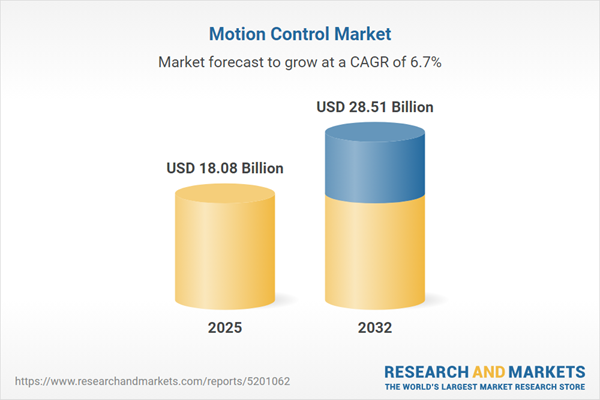Speak directly to the analyst to clarify any post sales queries you may have.
The motion control market is navigating a critical transformation, propelled by advancements in precision automation, evolving digital technologies, and dynamic shifts in the global supply chain.
Market Snapshot: Motion Control Market Size and Growth
The Motion Control Market grew from USD 16.92 billion in 2024 to USD 18.08 billion in 2025 and is expected to maintain a CAGR of 6.73%, reaching USD 28.51 billion by 2032. This growth reflects mounting demand for advanced motion systems across sectors such as manufacturing, semiconductor, and healthcare. The market’s expansion is closely linked to strategic investments in automated systems, digital engineering, and resilient supply networks.
Scope & Segmentation
This report provides an in-depth analysis of the motion control market, covering core segments, regional landscapes, and key technology drivers.
- Motion Types: Linear, Multi Axis (2 Axis, 3 Axis, 5 Axis), Rotary
- End User Industries: Aerospace and Defense (Commercial Aerospace, Defense), Automotive (Aftermarket, OEMs), Healthcare (Hospitals, Laboratories), Manufacturing (Discrete Manufacturing, Process Manufacturing)
- Components: Actuators (Linear Actuators, Rotary Actuators), Controllers (Motion Controllers, PLC Controllers), Sensors (Force Sensors, Position Sensors, Speed Sensors), Software (Design, Programming, Simulation)
- Applications: Automotive, Industrial Automation (Assembly, Material Handling, Packaging), Medical Devices (Imaging Systems, Surgical Robots), Semiconductor Manufacturing (Lithography, Wafer Inspection)
- Regions: Americas (North America – United States, Canada, Mexico; Latin America – Brazil, Argentina, Chile, Colombia, Peru), Europe, Middle East & Africa (Europe – United Kingdom, Germany, France, Russia, Italy, Spain, Netherlands, Sweden, Poland, Switzerland; Middle East – United Arab Emirates, Saudi Arabia, Qatar, Turkey, Israel; Africa – South Africa, Nigeria, Egypt, Kenya), Asia-Pacific (China, India, Japan, Australia, South Korea, Indonesia, Thailand, Malaysia, Singapore, Taiwan)
- Key Companies: Siemens Aktiengesellschaft, Mitsubishi Electric Corporation, Rockwell Automation, Inc., Schneider Electric SE, ABB Ltd., Yaskawa Electric Corporation, FANUC Corporation, Parker-Hannifin Corporation, Emerson Electric Co., Bosch Rexroth AG
Key Takeaways: Strategic Insights for Senior Leaders
- Rapid evolution in digital control and simulation is streamlining integration and enhancing motion system reliability across multiple industries.
- System-level expertise—integrating actuators, controllers, sensors, and advanced software workflows—has become a differentiator within highly competitive verticals such as automotive electrification and semiconductor manufacturing.
- Cross-functional priorities, including safety validation, cybersecurity, and systems integration, are essential for achieving compliance and operational excellence in critical applications.
- Regionalized operating models, which combine global R&D reach with local manufacturing and service, help organizations build resilience and serve diverse customer priorities effectively.
- Modular architectures and lifecycle services, including predictive maintenance, underpin the creation of new recurring revenue streams and support long-term customer engagement.
- Competitive success now demands that motion control providers tailor commercial agreements and risk-sharing approaches to address ongoing supply and tariff-related disruptions.
Tariff Impact: Operational and Strategic Responses
Tariff actions enacted in 2025 have added layers of complexity for global motion control value chains. Sourcing strategies have shifted, compelling manufacturers and integrators to diversify suppliers, explore onshoring initiatives, and modify product designs to reduce cost exposure. Negotiations increasingly emphasize risk-sharing provisions, while suppliers with geographically-flexible operations are better positioned to retain contracts and manage disruption. Leaders are focusing on flexible procurement and rapid redesign to respond to these policy shifts without compromising technical performance.
Methodology & Data Sources
This report is based on a rigorous, multi-method approach. Primary research included expert interviews with system integrators, engineers, and procurement leaders. Technical validation exercises ensured accuracy in component performance claims, while secondary data triangulated findings from public filings, standards documentation, and patent analysis. Clear documentation of assumptions and sources delivers robust, actionable conclusions.
Why This Report Matters
- Enables senior executives to clarify technology, market, and risk priorities for both immediate decision-making and long-term planning.
- Delivers a structured, cross-functional framework to align product development, sourcing strategies, and commercial models in the evolving motion control ecosystem.
By synthesizing critical technologies, regional dynamics, and commercial strategies, this resource supports investments that maximize operational flexibility and profitability.
Conclusion
The motion control market is evolving through digital advances, new business models, and global supply-chain shifts. Organizations that prioritize modularity, digital engineering, and regional resilience will capture valuable opportunities in this landscape.
Additional Product Information:
- Purchase of this report includes 1 year online access with quarterly updates.
- This report can be updated on request. Please contact our Customer Experience team using the Ask a Question widget on our website.
Table of Contents
3. Executive Summary
4. Market Overview
7. Cumulative Impact of Artificial Intelligence 2025
Companies Mentioned
The companies profiled in this Motion Control market report include:- Siemens Aktiengesellschaft
- Mitsubishi Electric Corporation
- Rockwell Automation, Inc.
- Schneider Electric SE
- ABB Ltd.
- Yaskawa Electric Corporation
- FANUC Corporation
- Parker-Hannifin Corporation
- Emerson Electric Co.
- Bosch Rexroth AG
Table Information
| Report Attribute | Details |
|---|---|
| No. of Pages | 192 |
| Published | October 2025 |
| Forecast Period | 2025 - 2032 |
| Estimated Market Value ( USD | $ 18.08 Billion |
| Forecasted Market Value ( USD | $ 28.51 Billion |
| Compound Annual Growth Rate | 6.7% |
| Regions Covered | Global |
| No. of Companies Mentioned | 11 |









